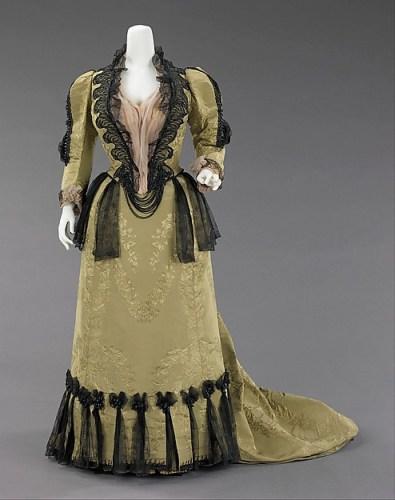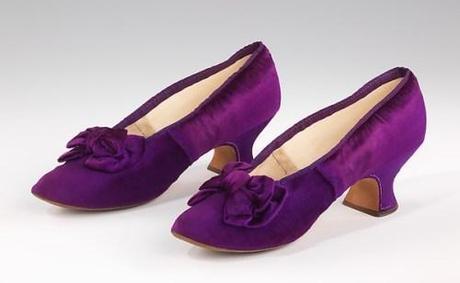
Opera cape, 1898. Photo: Metropolitan Museum of Art, New York.
As some of the more keen eyed among you may have noticed, I am about to turn forty in the next few weeks and have been rather ineptly working my way through a list of things that I feel like I REALLY NEED TO DO before I hit this milestone birthday. I’ll be honest, when I put ‘go to the opera’ on the list, it wasn’t actually with the expectation of actually being able to go as, although I like to think of myself as a relatively cultured sort of person, I’ve always thought that going to the opera wasn’t really my scene.
However, it now looks like I might actually be gracing the ENO with my presence this autumn – and what better time of year can there be to visit the opera? All those long, dark nights and the lush glamour and glitz of oncoming Christmas. The highlight of this winter’s season is their production of La Bohème, Puccini’s iconic tale of 1840s hipsters living in Parisian garrets, which was first performed in Turin in February 1896.

Fan, Tiffany, c1890-9. Photo: Metropolitan Museum of Art, New York.
As a visit to the opera is, like the almost compulsory ball scene, an apparently essential part of most historical fiction, generally as a backdrop to flirtation, I’ve always felt a fascination with all the glamorous accessories required for such an excursion and thought it might be fun to take a look at the sort of thing a lady of fashion might have worn to the premiere of La Bohème.

Evening dress, Rouff, c1897. Photo: Metropolitan Museum of Art, New York.

Evening dress, Rouff, c1895. Photo: Metropolitan Museum of Art, New York.

Evening dress, Worth, c1897. Photo: Metropolitan Museum of Art, New York.

Evening dress, Worth, 1893. Photo: Metropolitan Museum of Art, New York.
Although the dress code nowadays is rather more casual, the nineteenth century opera house was a glorious, glittering spectacle of society ladies in opulent silks and velvets, with a fortune’s worth of pearls and diamonds bedecking their persons, while their silk and feather fans wafted back and forth in time to the music.
This selection of evening gowns from the late 1890s is typical of the sort of thing that might have been worn to the opera during this period – an outing that required something much more special than an ordinary evening gown and yet just a touch less flounced and glitzy than the sort of dresses that would be worn to balls and parties, although what they lacked in glitz was more than amply made up for with a bit of theatrical swagger, which was thought exceedingly suitable for an evening at the opera. To modern eyes, perhaps, all of these gowns probably look equally as over the top as each other but to a lady of fashion at the end of the nineteenth century, there would have been subtle little differences between the sorts of dresses that she might have considered suitable for the theatre, opera, balls and private concerts.

Evening shoes, Ferry, c1890. Photo: Metropolitan Museum of Art, New York.

Evening oxford shoes, Cammeyer, c1891. Photo: Metropolitan Museum of Art, New York.

Evening shoes, Parlor Shoe Store, c1894. Photo: Metropolitan Museum of Art, New York.
Ladies of fashion have loved shoes since lONG before Carrie Bradshaw set perfectly shod foot on New York’s pavements (sidewalks, whatever) and an evening at the opera was the perfect occasion to showcase some really fabulous footwear as, just like nowadays, women would save their most impractical and beauteous shoes for occasions when they were going to be spending most of the evening sitting down in one spot and doing very little walking about.
Cute little silk and satin pumps were de rigueur for balls, and were generally treated as disposable as they would generally fall apart after a couple of wears due to all the hectic dancing and socialising going on. Shoes worn for more sedate evenings at the opera, however, are much more likely to have survived to the present day.

Opera bag, Lemiere, c1910. Photo: Victoria and Albert Museum, London.

Evening bag, c1900. Photo: Metropolitan Museum of Art, New York.

Evening bag, c1860. Photo: Metropolitan Museum of Art, New York.

Lorgnettes, 1890s. Photo: Metropolitan Museum of Art, New York.

Lorgnette and chain, Lalique, c1900. Photo: Metropolitan Museum of Art, New York.

Fan, c1900. Photo: Metropolitan Museum of Art, New York.

Fan, c1900. Photo: Metropolitan Museum of Art, New York.

Evening gloves, fourth quarter 19th century. Photo: Metropolitan Museum of Art, New York.
Just like now, accessories formed an important part of any evening ensemble, and especially so when there was an outing to the opera involved as this would necessarily have involved a variety of appurtenances. The elegant opera bag in the collections of the Victoria and Albert Museum is an excellent example of this, with contents that included telescopic opera glasses, change purse, folding fan, mirror, bone notecard, pencil and white swansdown powder puff: everything in fact that a fashionable lady could possibly require during an evening out.
For less organised ladies then a lovely glittery bag would have been just fine so long as it had space for those all important lorgnettes, opera libretto and fan. Also essential was a pair of long elegant white evening gloves, which no fashionable, well heeled lady would ever be seen without. Add some rice powder, rouge and khol as well as a touch of an expensive Parisian perfume and the outfit was complete.
Of course, when I’ll be making rather less ostentatious effort if I go to the opera, but it’s still a place where flamboyant, dramatic clothes and a bit of eccentric, bohemian chic are pretty much the order of the day and of course the spectacle unfolding on stage is every bit as opulent and gripping as it has ever been.
******
Set against the infamous Jack the Ripper murders of autumn 1888 and based on the author’s own family history, From Whitechapel is a dark and sumptuous tale of bittersweet love, friendship, loss and redemption and is available NOW from Amazon UK and Amazon US.
‘Frothy, light hearted, gorgeous. The perfect summer read.’ Minette, my young adult novel of 17th century posh doom and intrigue is now 99p from Amazon UK and 99c from Amazon US. CHEAP AS CHIPS as we like to say in dear old Blighty.
Blood Sisters, my novel of posh doom and iniquity during the French Revolution is just a fiver (offer is UK only sorry!) right now! Just use the clicky box on my blog sidebar to order your copy!
Follow me on Instagram.
